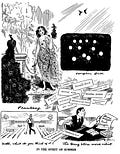I loathe regulated thresholds—not their existence as such, but the premise of systems which allow for a precise amount of malfeasance before they come knocking.
Consumer goods may expose us to up to the defined threshold of forever chemicals, or PFAS. Never mind that all of us consumers are encouraged everywhere we look to consume the latest and greatest, replacing the old with the new, inherently contributing to the accumulation of forever chemicals over time.
US states, not the federal government, are each tasked with legislating precisely how easily a mass shooter can execute people in crowds by limiting how high a weapon’s high-capacity magazine can be. More than five years ago, the shooter in the 2017 Las Vegas massacre was able to fire 100 rounds in just 10 seconds—without having to pause and reload—because he used a large capacity magazine, bump stock, and an assault rifle in his attack which killed 50 and injured hundreds. As of this writing, all but 13 states and the District of Columbia still can’t be bothered to put any limit on magazine capacity.
Yours and my local police department can’t track our every movement and then correlate it to our names to build a profile. They can only track our every movement, track our known associates, and profile our ‘patterns of life.’ And plenty of other stuff, but not our names— that infringement threshold is one we don’t cross in the US.
And our waiting rooms are getting pretty crowded,
It is sad to see our patients sit and bleed,
But if you must use our ointment then you must have an appointment,
Or who'll pay for those magazines you read.
If you watch professional sports in the US, you’ve likely been subjected to the announcers’ cringey promotions of the latest COVID booster. Having a lifelong allegiance to the Boston Celtics, I get to hear Beantown’s own Moderna have their ad spot for the 2022-2023 NBA season’s first round of boosters promoted by the hometown announcers. Never mind that further boosters are demonstrably beneficial only to older viewers.
But there’s a threshold for that. As pharmaceutical industry publication FiercePharma reports—
As mRNA rivals Pfizer and its partner BioNTech kick off their COVID booster ad campaign this NFL season, Moderna is also keeping up and launching a new DTC [Direct to Consumer] commercial.
But just like Pfizer, Moderna is having to play it cool with the branding side of things for its 15-second spot “Get Boosted this Fall,” which began airing this month. That’s because both Pfizer-BioNTech and Moderna are promoting tweaked versions of their original vaccines but neither have full FDA approval yet.
The FDA emergency use authorizations for both vaccines, which have been tailored to the new omicron variant, came last month. But EUAs limit the marketing capacity for pharmas to promote their drugs.
That’s why Moderna's latest ad—like Pfizer's—has more of an awareness campaign feel. The Spikevax name is not mentioned, nor is there a direct mention of its booster vaccine. The ad simply says that “updated boosters help protect against variants,” with the plural 'boosters' being a quiet nod to Pfizer-BioNTech’s omicron booster.
They say what they can, as their shareholders demand. The report continues—
Moderna made tens of billions of dollars for its Spikevax vaccine in 2021 but will struggle for sales this year as most adults have had their round of shots. Making shots annual and variant-specific should help pick up some of that lost revenue, though adoption of the latest mRNA boosters has been weak.
Around 4.4 million people got the updated COVID booster this month, according to data released last week by the Centers for Disease Control and Prevention. That's just 1.5% of people eligible to receive the shots in the U.S. Clearly both Pfizer and Moderna are turning to the old pharma playbook of spending on DTCs to help shore up these figures.
Seeking refuge in sports entertainment, as elsewhere, is an exercise in continual subjection to up to the legal limit of this or of that.


